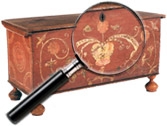|
|
Cartouche – Definition
The decorative arts world has many “squishy” and vague vocabulary words, but few are “squishier” and vaguer than cartouche. Originally, the term comes from Egyptology and is used to describe a oval enclosing hieroglyphics and having a horizontal line at one end. (The line denotes royalty.) The oval had significance not unlike that of a closed circle, in that it was believed that an oval around a person’s name provided protection [...] Click here to continue reading.
Sotheby’s Catalogue Note regarding the silver hand seal of the 1st Continental Rifle Regiment.
Sotheby’s, Important Americana, 24-25 January 2014.
Catalogue Note: Lost to time for over two hundred years and recently rediscovered, this silver seal is one of only two surviving objects related to the famous 1st Continental or Rifle Regiment, the first American unit to be raised, equipped and paid directly by the Continental Congress. Also known as the Continental Rifle Regiment, [...] Click here to continue reading.
Bakelite
Scandal & the Story of Bakelite Bakelite hit the market in 1907, heralding the arrival of the modern plastics industry. Bakelite was the first completely man made plastic, as until then, plastics such as celluloid, casein, and Gutta-Percha all had as a base a natural material. It was developed by Belgian-born chemist Dr. Leo Hendrick Baekeland who started his firm General Bakelite Company to produce the phenolic resin type plastic. Bakelite was inexpensive [...] Click here to continue reading.
Jesse Woodson James, American Outlaw
Courtesy of James Julia Auction Company, presented in conjunction with the sale of Jesse James’ personal Colt revolver and holster rig (p4A item # D9737835)
Jesse Woodson James was born Sept. 5, 1847 in Clay County, Missouri. He had an older brother, Frank and a sister. His father, a minister, left soon after Jesse was born to go to California to “minister” to the 49er miners. He died in [...] Click here to continue reading.
The Sarcophagus in Decorative Arts
Derived from the Greek sarx, meaning flesh, and phagein, meaning eat, a sarcophagus is, essentially, a container for a body, much like a coffin or casket. Historically, sarcophagi were typically made of stone (though sometimes of other materials, such as wood or metal), with a relief-carved or pediment top, and designed to be above ground, and have been used by many cultures since ancient times.
An ancient [...] Click here to continue reading.
Shakudo – Definition
Shakudo is the Japanese term for a copper and gold alloy consisting of 2% to 7% gold and the remainder copper. This alloy can then be treated to achieve a blue-black color sometimes resembling lacquer. It was historically used to make and/or decorate Japanese swords. Contemporary jewelry makers have revived the use of shakudo for its unusual and beautiful coloring.
p4A editorial staff, March 2013
John Singleton Mosby (1833 to 1916)
John Singleton Mosby (1833 to 1916) enlisted in a Virginia cavalry unit at the outbreak of the Civil War. He and one other in his unit were ready to re-enlist at the end of their year of service. He was head of his regiment for only two months, but long enough to get the attention of J.E.B. Stuart. Stuart invited him to serve as a scout, and throughout [...] Click here to continue reading.
Confederate Captain Frank Gurley
Courtesy of Cowan’s Auctions
Frank Ballou Gurley was born in 1834 in northern Alabama, where his father and grandfather had moved in 1818. He grew up in a rapidly growing settlement that would eventually be called “Gurley,” just east of Huntsville in the fertile soils of the Tennessee River. When war broke out, Gurley enlisted in July 1861 in Rev. David Kelly’s (Kelley) cavalry. Meanwhile, Nathan Bedford Forrest was recruiting [...] Click here to continue reading.
Flag Act of 1777
The first national flag of the United States, known as the Continental Colors, retained the Union Jack in the canton. The flag act of 1777 mandated that stars replace the British Union flag to which the act referred to as “a new constellation”. The act, however, failed to lay down a firm design as to how the stars should be arranged and manufacturers of “Old Glory” incorporated their own placement [...] Click here to continue reading.
Archive of Colonel Joseph C. Audenried
Born into a well to do Philadelphia family, Joseph C. Audenried (1839-1880) enjoyed a privileged seat at the table of history. Handsome, intelligent, and supremely efficient, he made the most of his innate talents and good fortune as he built a truly unique career, becoming one of the most trusted members of the staff of Maj. Gen. William T. Sherman.
A career military man, Audenried graduated 17th in [...] Click here to continue reading.
|
Recent Articles
- Charles Alfred Meurer – American Artist & Tromp L’Oeil Artist
- Sendak, Maurice – American Artist & Writer
- Godie, Lee – American Artist
- Davis, Vestie – American Artist
- Bartlett, Morton – American Artist
- Mackintosh, Dwight – American Artist
- Evans, Minnie Jones – African-American Artist
- Mumma, Ed (Mr. Eddy) – American Artist
- Nice, Don – American Artist
- Savitsky, John (Jack) – American Artist
- Gordon, Harold Theodore (Ted) – American Artist
- Dial, Thornton – African-American Artist
- Doyle Sam – American Artist
- Johnson, Lester Frederick – American Artist
- Finster, Howard – American Artist
|
|
